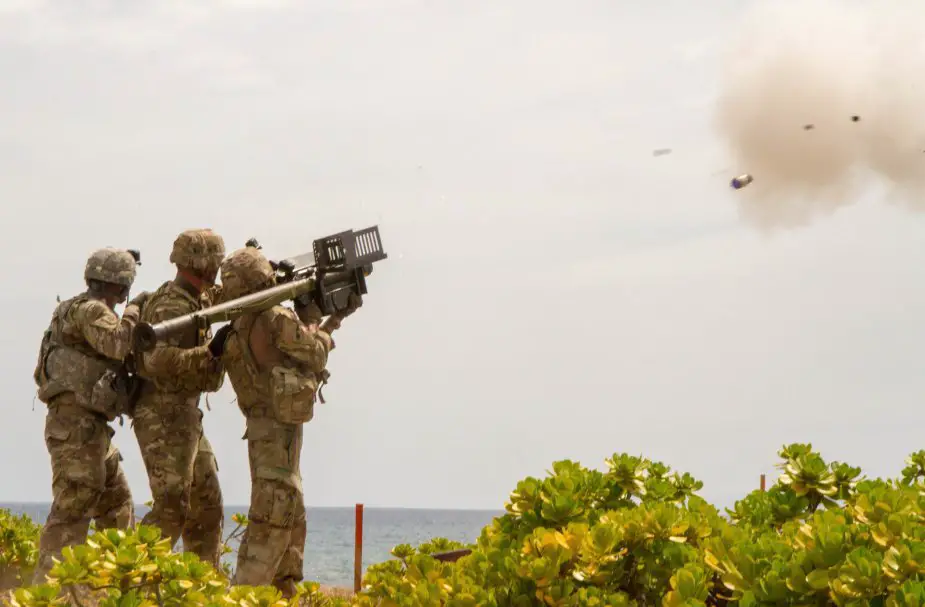US Army leaders have released the latest version of the service's future fighting concept, which focuses on, among other things, possible solutions to counter and defeat layers of stand-off created by adversaries. "The U.S. Army in Multi-Domain Operations 2028," also referred to as MDO Concept 1.5, further refines the Multi-Domain Battle concept published last year.

Soldiers participating in the Multi-Domain Task Force pilot program launch a stinger missile using a man-portable air defense system during the Rim of the Pacific exercise at Pacific Missile Range Facility Barking Sands, Hawaii, July 24, 2018
(Credit: Capt. Rachael Jeffcoat)
The name was changed to better align with sister services and interagency efforts.
In it, the concept asserts that over the years adversaries have studied how the U.S. military operates. Emerging technologies -- such as artificial intelligence, hypersonics, machine learning, nanotechnology and robotics -- have also changed the character of war.
"The American way of war must evolve and adapt," Chief of Staff of the Army Gen. Mark A. Milley wrote in the foreword of the concept, which was published Thursday.
Though not the final product, Milley noted that MDO Concept 1.5 is the first step in the service's doctrinal evolution.
"It describes how U.S. Army forces, as part of the Joint Force, will militarily compete, penetrate, dis-integrate, and exploit our adversaries in the future," he wrote.
In about a year, Army leaders expect to publish another updated concept using lessons learned from previous exercises. The general also encouraged Soldiers to read and understand the concept now, so that they can provide input.
"Every one of you is part of our evolution and the construction of our future force," he wrote, "and we want your critical feedback."
While the latest concept still revolves around operations in the land, maritime, air, space and cyberspace domains, it provides refined solutions based on experimentation.
A challenge the new concept aims to tackle is layered stand-off, which adversaries can use in those domains to achieve strategic aims without engaging in armed conflict. Those aims, for instance, could be to separate the United States from its partners in the political, military and economic realms.
Deterrence through the "rapid and continuous integration of all domains" is key in overcoming this challenge, according to Gen. Stephen Townsend, commander of Army Training and Doctrine Command.
"If deterrence fails," he wrote in the concept's preface, "Army formations, operating as part of the Joint Force, penetrate and dis-integrate enemy anti-access and area denial systems; exploit the resulting freedom of maneuver to defeat enemy systems, formations and objectives and to achieve our own strategic objectives; and consolidate gains to force a return to competition on terms more favorable to the U.S., our allies and partners."
Army leaders believe they can do this by using three core tenets -- calibrated force posture, multi-domain formations, and convergence.
"Calibrated force posture combines position and the ability to maneuver across strategic distances," Townsend wrote. "Multi-domain formations possess the capacity, endurance and capability to access and employ capabilities across all domains to pose multiple and compounding dilemmas on the adversary.
"Convergence achieves the rapid and continuous integration of all domains across time, space and capabilities to overmatch the enemy. Underpinning these tenets are mission command and disciplined initiative at all warfighting echelons."
Based on foundational work by TRADOC and Army Capabilities Integration Center, the Army Futures Command, which was created last year to lead modernization efforts, will implement the concept. It will also work to develop MDO Concept 2.0.
"The Army is refining strategic direction, integrating the Army's future force modernization enterprise, aligning resources to priorities, and maintaining accountability for modernization solutions," said Gen. John Murray, the AFC commander. "We are delivering concepts and capabilities that ensure our Soldiers and formations have overmatch on future battlefields."
The concept will take years to refine as did the Army's previous AirLand Battle concept, which took a decade to finalize.
A Multi-Domain Task Force has already tested in the Pacific theater some new capabilities to defeat an enemy's anti-access and area denial, or A2/AD, system.
Designed to integrate long-range precision fires with an intelligence, cyber, electronic warfare and space detachment, the task force could support, or enable, a new way to fight.
"Given its capability to compete and provide an initial penetration, the MDTF, as a forerunner to other multi-domain formations now in development, is the essential first step to realizing an MDO-capable Army by 2028," the concept states.
The Army has also worked extensively with the Marine Corps and Air Force in the past 18 months to further refine the concept.
TRADOC and the Air Force's Air Combat Command, for instance, teamed up during four multi-service tabletop exercises over the past year.
"What has become clear is that a single-service concept without undergoing a lot of joint or multi-service experimentation probably has little value in the future," said Brig. Gen. Mark Odom, director of ARCIC's Concept Development and Learning Directorate.
As a component of the Army Strategy, Odom said, the concept also attempts to operationalize the National Defense Strategy and National Military Strategy.
The concept is significant for three reasons, he noted.
First, it focuses on solving operational problems that strategic competitors like Russia and China present to the Joint Force.
"This represents a return to a threat-based approach rather than a capabilities-based approach to concept development," he said.
Second, the concept is inherently joint and recognizes the requirement to develop joint solutions from the top-down.
"Our traditional approach of synchronizing federated or service-federated solutions," he said, "will not work against Russia and China in the future."
Lastly, he added, the concept provides a hypothesis to drive experimentation and modernization.














